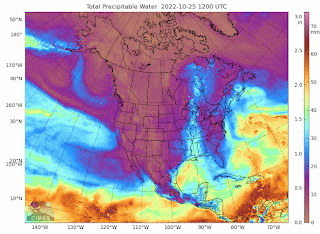The Physics Forecast is an attempt to get a forecast a little bit longer than normal. It uses physics first principles such as 'hot air rises', and basic energy transfer. This is unavailable in the normal forecasting world because touching physics blows up the fantasy picture. The uncertainties start lower with a few months, and rise to 'meaninglessness' at 6 months. The Popular People can forecast without uncertainties up to 50 years.
This maps is 'precipitable water', and is the best display for atmospheric heat energy. The plumes are produced by heat energy transfer from the oceans. The short term forecast comes from the plumes, and the long forecast comes from the ocean. The working hypothesis is that 'heat flow' is the dominant factor for future weather.
I'm just sticking to North America for now, forget all those other places. Here we see very powerful cold air blobs, air glaciers coming down and pushing the plumes around. The cold air has no heat energy, but it can suck up heat energy, and has higher density, with momentum. During the warm cycle, the plumes had greater energy, but now, in absence of that, we have these 'air glaciers'.
The plumes are so weak that we had stagnant air for the past month or two in the west. This has now been blown away by a cold blob, clob, similar to the famous 'Texas Freeze'. It is coming on to the east along a big front.
Europe will most likely get hit by that leftover stagnant hot air blob.
The long term hypothesis remains the same -- the ocean belts have a non-linear mechanism for acquiring solar heat. This is because of the action of water vapour which acts as a giant heat pipe, with the water going up and down, along with violent storm action. It was on full blast during the warm cycle, and is now totally shut down. The Pacific Ocean is stuck in a permanent 'La Nina'. Australia will become a rain forest. Canada goes back to 1830 winters. The cold cycle will either be 2-40 years, or go straight on to the 300 year 'Little Ice Age' cycle.



.png)
No comments:
Post a Comment